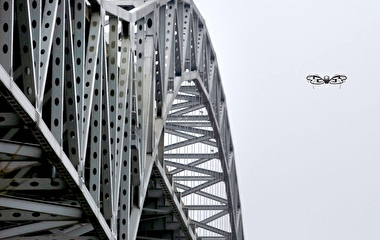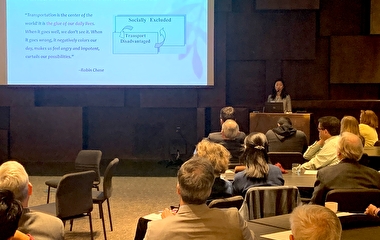On August 1, 2007, the I-35W Saint Anthony Falls Bridge collapsed in Minneapolis. Its replacement, open to traffic just over a year later, was instrumented with more than 500 sensors to record the new structure’s behavior and evaluate the effectiveness of different monitoring strategies. A 10-year review of the bridge’s monitoring system is now available from U of M researchers.
“The measurements collected over the 10 years of monitoring, with the aid of material tests, truck tests, and finite element modeling, provide insight regarding the relative strengths of the instrumentation systems and potential considerations for future system deployments,” says Lauren Linderman, assistant professor in the Department of Civil, Environmental, and Geo- Engineering (CEGE) and the project's principal investigator.
The continuous operation of the I-35W bridge monitoring system makes it one of the longest-lived in the country. The system incorporates many sensor types, including strain, temperature, and acceleration and displacement sensors, and has generated a uniquely large data set. “This data set offers an unmatched opportunity to evaluate long-term monitoring approaches,” Linderman says.
Project co-investigators were Carol Shield (CEGE professor) and Brock Hedegaard (civil engineering assistant professor, U of M Duluth). The project was sponsored by the Minnesota Department of Transportation.
"This project has given us more knowledge in how we may be able to better instrument bridges in the future if we find it necessary to monitor or investigate their behavior," says Ben Jilk, principal engineer with MnDOT's Bridge Office. “It has also given us confidence that the design criteria we have been utilizing on bridges in Minnesota like the I-35W bridge is conservative with respect to the behavior observed.”
The team’s report documents the successes and challenges of the monitoring program. In particular, the researchers studied the effectiveness of different strain measurement techniques and sensor distributions.
Overall, the instrumentation survival rate was approximately 90 percent over the 10 years. “This is significant given the deployment duration, embedment of gages, and variety of sensor systems,” Linderman says.
Researchers leveraged the monitoring system in different ways throughout the project. Some instrumentation, for example, helped the team calibrate the model used for behavior comparisons and validate design assumptions.
One key finding from the project is that seasonal and daily temperature variations have a big impact on the bridge’s behavior. As a result, the instrumentation needed to measure temperature and its impacts is the most important for long-term monitoring.
“Currently, one cross-section is heavily instrumented to capture temperature data, but behavior at this cross-section varied significantly from behavior near the piers,” Linderman says. “For future bridge deployments, we recommend instrumenting more cross-sections, with fewer sensors, to get a more accurate representation of the temperature distribution throughout the structure. This could be essential as the temperature-dependent behavior starts to dominate the bridge’s response, and the time-dependent effects slow down.”
These large thermal stresses—in particular, those caused by low temperatures during morning rush hours—could lead to concerns about deck cracking.
“This bridge used a conservative design approach, so we believe its service life won’t be affected,” Linderman says. “Comparable bridges, however, could encounter issues. The insight gained from this study could be key for their design and life span.”




